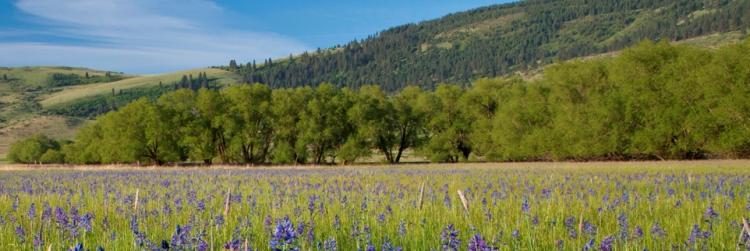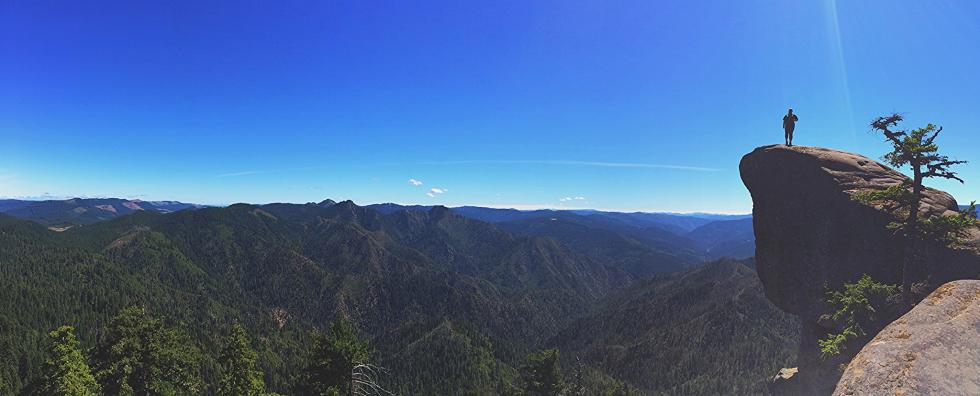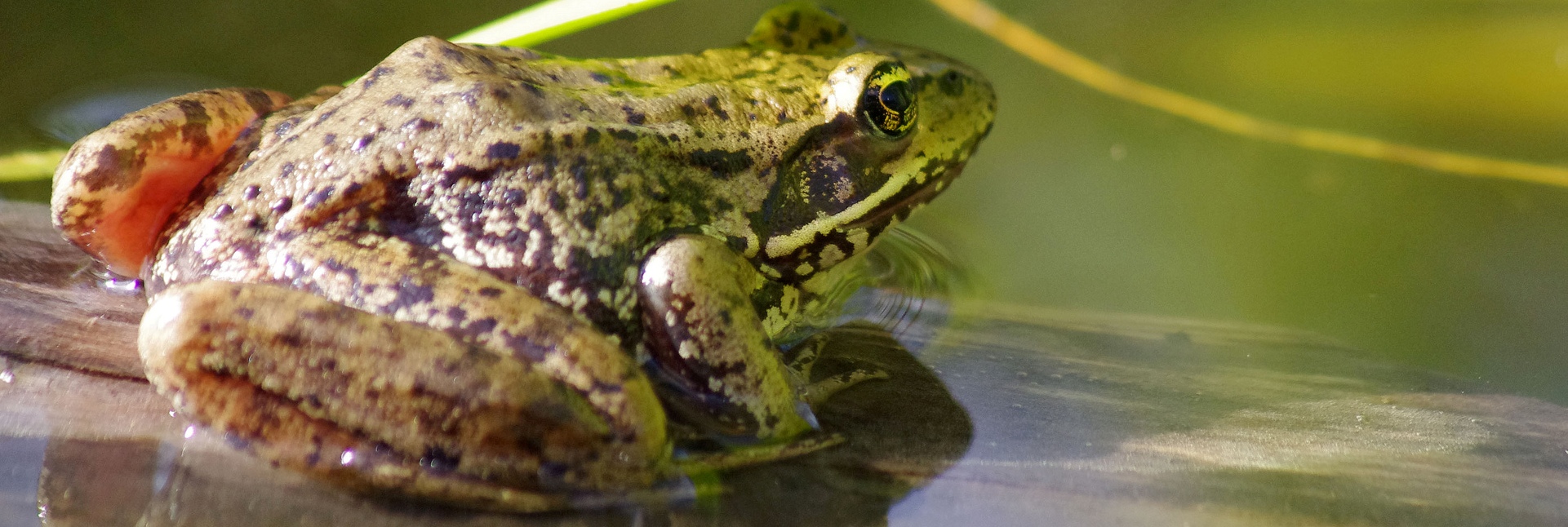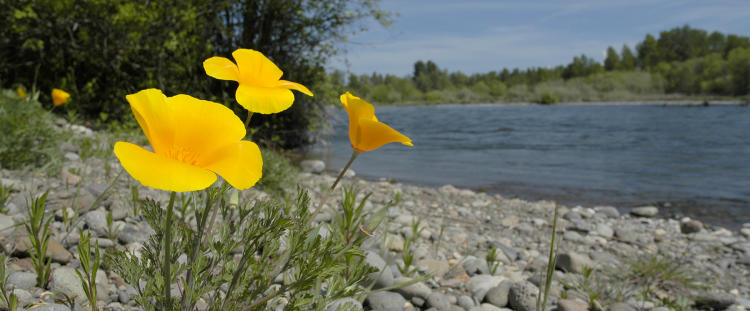
Introduction
The Oregon Conservation Strategy represents Oregon’s first overarching state strategy for conserving fish and wildlife. It uses the best available science to create a broad vision and conceptual framework for long-term conservation of Oregon’s native fish and wildlife, as well as various invertebrates, plants, and algae.
The Conservation Strategy emphasizes proactively conserving declining species and habitats to reduce the possibility of future federal or state listings. It is not a regulatory document but instead presents issues, opportunities, and recommended voluntary actions that will improve the efficiency and effectiveness of conservation in Oregon.
Most importantly, it establishes the basis for a common understanding of the challenges facing Oregon’s fish and wildlife, and provides a shared set of priorities for addressing the state’s conservation needs. The heart of the Conservation Strategy is a blueprint for voluntary action to address the long-term needs of Oregon’s fish and wildlife. The future for many species will depend on landowners’ and land managers’ willingness to voluntarily take action on their own to protect and improve fish and wildlife habitat.
Oregon Conservation Strategy Goals:
- Maintain healthy fish and wildlife populations by maintaining and restoring functioning habitats.
- Prevent declines of at-risk species.
- Reverse declines in these resources where possible.
The Conservation Strategy is not a management plan for the Oregon Department of Fish and Wildlife. It is a broad strategy for all Oregonians, offering potential roles and opportunities for citizens, private landowners, organizations, and agencies alike. It incorporates information and insights from a broad range of natural resources assessments and conservation plans, supplemented by the professional expertise and practical experiences of a cross-section of Oregon’s resource managers and conservation interests. Healthy fish and wildlife populations require adequate habitat, which is provided in natural systems and in landscapes managed for forestry, agriculture, range, and urban uses.
This document is called a strategy, not a plan, because its purpose is to help people make decisions more strategically about how they can invest time and resources in fish and wildlife conservation. The intent is for localized or species-specific plans to tier off of the broader, overarching Conservation Strategy.

Oregon’s Unique Natural Heritage
Oregonians have always been proud of the place they live, proud of the diversity of landscapes and people, and of Oregon’s strong ties to our fish and wildlife. The Oregon Conservation Strategy celebrates Oregon’s natural heritage by outlining goals and identifying actions that conserve and restore Oregon’s species, habitats, and ecosystems. The recommendations within the Strategy can be used to address species and habitat conservation needs, expand existing partnerships and develop new ones, and provide a context for balancing Oregon’s conservation and development priorities.
Oregon is a melting pot of traditions, cultures, ecological regions, geological formations, and political ideologies. Oregon’s varied geology, soil, and climate support a unique collection of species and habitats, which help define the state’s culture and economy. Oregon’s prosperity depends on use of land for agriculture, timber, industry, ranching, and outdoor recreation. These working landscapes, along with wilderness and other natural areas, provide the rich mix of habitat that supports Oregon’s fish and wildlife.
There are, however, significant challenges to maintaining Oregon’s fish and wildlife. Habitats have been fragmented or degraded by construction of towns and roads, alteration of river systems, and intensive land management practices. Some areas have been completely converted to other uses. While not all land conversion results in habitat loss, the changes people have made to habitats can isolate fish and wildlife habitats into increasingly smaller patches, limit the functions that habitats provide for species, and ultimately make it more difficult for ecosystems to provide the services that define Oregon’s history, culture, and economy.
The Strategy provides an adaptive and comprehensive framework for continued positive action and new innovation. Building upon previous plans, it provides a menu of recommended voluntary actions and tools to help inspire local communities, landowners, and citizens to define their own conservation role.
Oregonians have long demonstrated their willingness to work together for the common good. Tapping that spirit will encourage new alliances, partnerships, coordination, and collaboration among agencies, tribes, organizations, businesses, and landowners to take care of Oregon’s unique natural treasures.

Oregon Conservation Strategy: What It Is and What It Can Do
The goals of the Oregon Conservation Strategy are to: 1) maintain healthy fish and wildlife populations by maintaining and restoring functioning habitats, 2) prevent declines of at-risk species, and 3) reverse declines in these resources where possible.
The Strategy is intended to provide a long-term, big-picture blueprint for conserving Oregon’s natural resources for today and for future generations. It outlines how and where the state and its conservation partners, including landowners and land managers, can best focus this work. The Strategy is intended to:
- Prevent species from becoming imperiled, thereby reducing the risk of future species listings that could result in additional regulations for Oregon’s businesses and industries.
- Provide a wide range of voluntary conservation tools, so local communities and landowners can choose what is appropriate for their situations and goals.
- Provide a common conservation vision to guide state and federal agencies toward effective coordination.
- Leverage limited conservation resources, such as money, equipment, and time, in a more efficient and effective manner by:
- Focusing conservation actions on the species and habitats of greatest conservation priority
- Identifying areas where conservation activities will provide the greatest benefit at the landscape scale
- Increasing coordination, collaboration, and partnership to produce cumulative benefits
- Demonstrate how local conservation actions fit into a broader regional or statewide perspective.
- Provide a role for every Oregonian, from local neighborhood clean-ups to large-scale citizen-based monitoring.
- Encourage voluntary conservation and recognize contributions already made by landowners, land managers, and other entities.
- Increase the efficiency and conservation benefits of existing voluntary incentive programs, and identify additional needs.
- Provide guidance and coordination to preserve and restore the services provided by healthy ecosystems that benefit all Oregonians.
- Synthesize existing plans and credible, peer-reviewed science to provide a statewide context to address the state’s conservation needs.
- Expand the successful voluntary approach of the Oregon Plan for Salmon and Watersheds to maintain and restore upland areas for improved watershed function.
- Assist in managing landscapes to safeguard Oregon’s high quality of life and natural resource legacy, which is one of the state’s strengths in attracting and retaining businesses.
- Demonstrate Oregon’s commitment to conserve its species and habitats.
- Increase coordination among states to address issues of common concern.
- Serve as a long-term strategy for the next decade and beyond, while still remaining a dynamic, living approach that will be adjusted as new information and insights are gained.
Oregon Conservation Strategy: What It Is Not
The Strategy is not regulatory. It works within the existing legal structure and is not a substitute for regulations. It does not challenge, change, or expand regulations. It does not add any new regulations.
The Strategy is not restrictive. It will not impose limits or new requirements on private landowners or public land users. It is not intended to impose additional rules, fees, or processes. It instead encourages voluntary action and collaboration.
The Strategy is not a substitute for existing planning efforts. It synthesizes and builds upon existing planning efforts to weave them into a statewide framework for action. It also highlights ways to expand, enhance, and improve conservation work.
The Strategy is not an Oregon Department of Fish and Wildlife management plan. Rather, it is intended to be a conservation tool for all Oregonians. The issues identified in this document are often complex and cannot be solved by any one agency or entity. They require cooperative, coordinated approaches for long-term success.
Scope of the 2016 Update
New science, resources, and available data were used to update all sections of the Strategy during the 10-year comprehensive revision of the Oregon Conservation Strategy. Particular focus was paid to priority sections of the Strategy that were identified by external partners and Oregon Department of Fish and Wildlife (ODFW) programs. These key focal areas consisted of: Strategy Species, Strategy Habitats, Key Conservation Issues, Monitoring, Conservation Opportunity Areas, and facilitating the use of the Strategy. Efforts included:
- The Strategy Species list was updated using current science and research.
- Strategy Habitat mapping was greatly improved using new technologies and incorporating ongoing monitoring projects.
- Conservation Opportunity Areas were updated and refined using data on Strategy Species, Strategy Habitats, and Key Conservation Issues.
- The Conservation Strategy’s new web format facilitates user connections and movement between all sections of the Strategy, links to more specific, stepped–down planning efforts, and provides an opportunity to dynamically update supporting information on Strategy priorities.

Oregon Conservation Strategy: 10-year report
Role of the Oregon Conservation Strategy Since 2006
In the 10 years since the Conservation Strategy was first completed, it has continued to bring together diverse partners to identify common conservation priorities, encourage partnerships, and achieve conservation success, all without the need for regulation. Landowners, watershed councils, Soil and Water Conservation Districts (SWCDs), conservation organizations, outdoor interest groups, tribes, and state, federal, and local agency partners, and others find value in using a common set of priorities presented within the Strategy, including: Strategy Species, Strategy Habitats, COAs, and Key Conservation Issues. Consistent priorities and supporting information, such as mapping and reporting tools, help landowners and land managers take a strategic, big-picture view of Oregon’s landscape. The Conservation Strategy has also served as an information source, providing an introduction to Oregon’s conservation priorities and descriptions about natural resource issues and management approaches to various audiences.
Coordinate Conservation Priorities:
Agencies, conservation organizations, public interest groups, and private citizens focus conservation efforts on the priorities identified in the Conservation Strategy. Some examples from the past decade include:
- The Oregon Board of Forestry uses the Strategy in their Forestry Program for Oregon.
- The Bureau of Land Management (BLM) used the Strategy in their Draft Resource Management Plan/Environmental Impact Statement. This planning effort influences approximately 2.5 million acres of BLM-administered lands in western Oregon.
- The USFWS Surrogate Species Program used the Strategy Species list to help select surrogate species across the state.
- The Oregon Department of Transportation used the Strategy to help develop priorities for wildlife crossings.
- The collaborative Intertwine Alliance in the Portland area used the Strategy to develop a stepped-down Regional Conservation Strategy.
- The Oregon Greater Sage-Grouse Conservation Assessment and Strategy steps down from the overarching Conservation Strategy.
- The Oregon Wolf Conservation and Management Plan steps down from the overarching Conservation Strategy.
Focus Investments:
Several funding organizations use Conservation Strategy priorities as scoring criteria to evaluate proposals for conservation funding and to direct investments on the ground. Strategy Species, Strategy Habitats, and COAs are often cited as justification for conservation and restoration project proposals. Since the Oregon Conservation Strategy was approved in 2006*:
- ODFW has directed over $20 million in State Wildlife Grants towards Conservation Strategy priority actions on the ground.
- ODFW’s Willamette Wildlife Mitigation Program (WWMP) was established in 2010 to work with the Bonneville Power Administration and the State of Oregon to purchase wildlife mitigation properties within the Willamette Valley. Since 2010, the WWMP acquisitions have included over 9,000 acres within Conservation Strategy COAs, with another 1,400 acres in progress.
- The Farm Bill uses the Conservation Strategy to inform priorities and federal funding opportunities for easements, including both wetland and upland areas.
- The Oregon Watershed Enhancement Board, which administers funding for conservation and watershed enhancements, refers to the Conservation Strategy as an information source for grant applicants and has invested over $122 million in conservation and restoration activities within COAs.
- The U.S. Forest Service’s Forest Legacy Program uses the Conservation Strategy to assist in prioritizing funding for projects that improve fish and wildlife habitat in forestlands.
- The federal Forest Health Program uses COAs to evaluate grant proposals that address forest health.
- The Rocky Mountain Elk Foundation and its partners have undertaken projects to conserve and/or enhance habitat in over 14,000 acres within or near COAs.
- The Conservation Registry was established in 2008 as a way to record conservation actions across the landscape. It contains a record of nearly 6,000 unique projects, including habitat restoration, conservation, monitoring, research, and education happening within COAs.
- The Coalition of Oregon Land Trusts (COLT) has documented that over 32,000 acres of COLT properties have been protected within COAs, with an additional 16,000 acres having been protected by other land trusts and non-governmental organizations.
- Additionally, many conservation organizations, landowners, and local, state, and federal partners have invested in projects within or near COAs, or addressed Strategy Species and Strategy Habitats as part of other projects. For example, contributions from ranchers to water and wildlife conservation are described in the Oregon Cattlemen’s Association conservation report.
Information Source:
For readers with an interest in Oregon’s natural resources, the Conservation Strategy provides an introduction to conservation in Oregon and a summary of major conservation issues and priorities. Since the Oregon Conservation Strategy was approved in 2006:
- The information provided in the Strategy has been used by school programs, private landowners, and interested citizens to learn more about Oregon’s important natural resources and find a role in helping to conserve them.
- The Strategy has become an integral part of the Oregon Master Naturalist curriculum, providing an introduction to Oregon’s natural history for each ecoregion.
- The Oregon Forest Resources Institute has incorporated information from the Strategy into identification guides for Strategy Species in managed forest habitats.
- The Conservation Strategy provided the ability to further prioritize species, habitats, and areas (COAs) within the ODFW Crucial Habitat Assessment project, part of the Western Association of Fish and Wildlife Agencies Crucial Habitat Assessment Tool, a dynamic map defining crucial habitat for fish and wildlife consistently throughout the western states.

Oregon’s Existing Planning, Regulatory, and Voluntary Framework
Oregon has an existing conservation framework in the form of plans, regulations, and grass-roots voluntary efforts. These processes have built the knowledge base, standards, and relationships that set the stage for creating a statewide conservation strategy. The Strategy has built upon this framework to promote common goals.
The Strategy works to promote integration and innovation within Oregon’s existing conservation framework, recognizing that many important conservation actions are covered by regulatory requirements, but other actions are voluntary, and incentives or market-based approaches can be quite helpful.
Regulations – State and federal laws govern issues such as water quality, air quality, land use, and species protection. For example, the legal and institutional framework for maintaining private forestland is in place through the Oregon Board of Forestry’s Forestry Program for Oregon, the Forest Practices Act, and statewide planning Goal 4, Forest Lands.
Voluntary Efforts – From counting birds during the annual Christmas Bird Count to planting willows in riparian areas, watershed councils, nonprofit organizations, private landowners, and other interested citizens are already contributing voluntarily to conserving Oregon’s fish and wildlife through both organized and individual efforts.
Plans – Numerous planning efforts by a variety of entities have identified priority species, habitats, and actions within Oregon. These plans have all differed in their purposes, goals, and scales of analysis. Some examples of large-scale planning efforts include the Oregon Plan for Salmon and Watersheds and The Nature Conservancy’s Ecoregional Assessments.
The Strategy builds on all of these efforts to provide a framework for a cohesive, statewide, non-regulatory approach to habitat and species conservation. Implementation requires coordination among the state and federal agencies that implement existing regulations, and among a variety of groups that implement plans. The Strategy can also support and expand existing voluntary efforts. See the section on Oregon’s planning and regulatory framework for more information.
The National APproach
The U.S. Fish and Wildlife Service requires each U.S. state and territory receiving State Wildlife Grants to complete a State Wildlife Action Plan (i.e., the Oregon Conservation Strategy) and to update that effort at least every 10 years.
The emphasis of each state strategy is on voluntary measures and collaboration. A state strategy that imposed additional regulation or adversely affected the state’s economy and communities would not meet the intent or objectives of the State Wildlife Grants Program. Each strategy must address factors affecting the health of the nation’s fish and wildlife, particularly those species in greatest need of conservation. The goal is to manage fish and wildlife populations and their habitat as a public trust, maintained as a national heritage.
Each state strategy must contain eight elements addressing species, habitats, problems, conservation actions, monitoring, strategy review, interagency coordination, and public involvement.
| USFWS Required Eight Elements | Oregon’s Approach |
|---|---|
| 1. Gather information on the distribution and abundance of fish and wildlife species. | Identify Strategy Species, those most in need of conservation, and summarize key information about them. Improve Oregon’s ability to map species distribution using both observational data and modeling. Use species data to help identify COAs where conservation activities would benefit the greatest number of Strategy Species. |
| 2. Describe location and relative condition of key habitats and community types essential to conservation of these species. | Identify Strategy Habitats to conserve a broad suite of species that reflect the diversity of fish and wildlife in the state, and map COAs for Strategy Habitats, areas where conservation activities would have the greatest benefit and chances of success. |
| 3. Describe problems which may adversely affect these species or their habitats. Identify information needed to improve conservation of species and habitats. | Describe limiting factors for Strategy Species and Habitats, and data gaps where information is needed. The Strategy describes conservation issues and limiting factors for each Strategy Species and Strategy Habitat, and describes seven Key Conservation Issues identified because of their impacts to Strategy Species and Habitats throughout the state. The Strategy lists fish and wildlife diseases occurring in Oregon, and provides management approaches. |
| 4. Describe necessary conservation actions for species and habitats. | Outline conservation actions for Strategy Species and Strategy Habitats. Identify Conservation Opportunity Areas where conservation activities would benefit the greatest number of Strategy Species and Strategy Habitats. Provide management actions and approaches to counter Oregon’s Key Conservation Issues and diseases that threaten our fish and wildlife populations. |
| 5. Propose ways to monitor the effectiveness of these conservation actions and ways to adapt actions as information or conditions change. | Describe guidance for monitoring species and habitats. |
| 6. Describe procedures to review the Strategy at regular intervals (not to exceed 10 years). | Describe how reviews and updates will occur. |
| 7. Coordinate with federal, state, and local agencies and tribes that manage significant land and water areas or administer significant programs that affect species and habitat conservation. | Coordinate extensively with federal, state, county, and local governments, tribes, non-governmental organizations, interest groups, and private landowners in developing and implementing the Strategy. |
| 8. Engage the public in planning and implementing the Strategy. | A. Seek guidance from a Stakeholder Advisory Committee: a broad-based, geographically balanced committee representing outdoor interest groups, conservation groups, hunting and fishing interests, tourism interests, local governments, and organizations working with landowners.
B. Seek public input through public presentations. Solicit comments via an open public comment period. Incorporate public comment into the final version. C. Engage Oregonians throughout the state as the Strategy is updated and encourage participation in Strategy actions. |